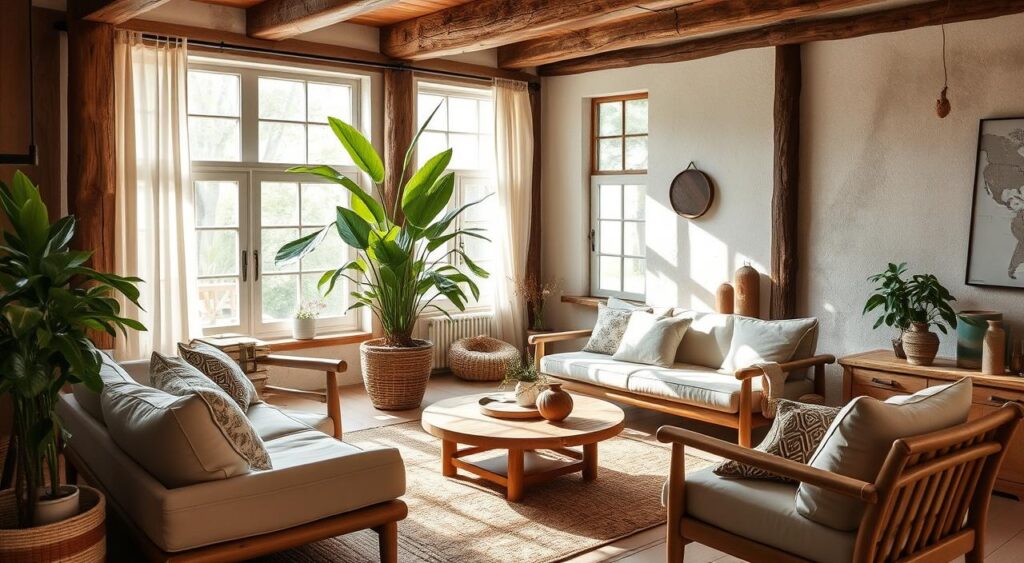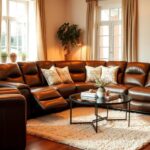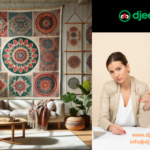In our era, eco-friendly interior design ideas are more than a trend; they’re a critical step towards sustainable living. Our homes, as our personal sanctuaries, play a significant role in the health of our planet and ourselves. By integrating green architecture and biophilic design into our living spaces, we envision a future in harmony with nature. As proactive citizens and homeowners, we can create environments that are not only beautiful but also eco-conscious.
The essence of this movement lies in the balance between our homes and the environment, fostering spaces where life thrives. Biophilic design is more than just adding plants; it’s about crafting an experience that reconnects us with nature. We take pride in designing spaces that honor the Earth, blending functionality with environmental responsibility. Our journey to a greener home begins here, as we delve into the various ways eco friendly interior design ideas can transform our living spaces.

Table of Contents
Key Takeaways
- Implementing eco friendly interior design supports environmental sustainability and personal well-being.
- Green architecture is integral to creating sustainable living spaces that minimize ecological impact.
- Biophilic design connects occupants with nature, promoting mental health and overall happiness.
- Sustainable home design is a responsible choice that contributes to the conservation of our planet.
- Eco friendly design is about forming a symbiotic relationship between our living spaces and the natural world.
Embracing Sustainability with Eco-Friendly Interior Design Ideas
As we move into the era of sustainability, adopting eco-friendly interior design is no longer just a trend. It’s a necessity. By grasping the basics and key principles of sustainable design, you’re taking a crucial step. This step helps reduce environmental impact and creates healthier living spaces.
Understanding the Basics of Eco-Friendly Design
Eco-friendly design aims to minimize the environmental impact of our living spaces. It involves using sustainable materials, saving energy, and reducing waste. A key aspect is choosing items that are made from renewable resources or produced sustainably.
Key Principles of Sustainable Interior Design
To fully embrace sustainable interior design, several foundational principles must be followed. First, using non-toxic paints is crucial for maintaining air quality and reducing harmful emissions. Second, zero-waste decor enhances aesthetics while avoiding clutter that ends up in landfills. Lastly, selecting materials with low environmental impact, like bamboo or recycled metal, conserves resources and supports sustainable manufacturing.

Integrating these elements into your home doesn’t mean sacrificing style or comfort. It’s about making informed choices that support long-term sustainability. By adopting these practices, you’re joining us in creating a greener, more sustainable future.
Incorporating Sustainable Materials in Your Decor
Exploring eco-friendly materials today reveals how they reflect our style and environmental commitment. From reclaimed furniture to bamboo flooring, each element is crucial in creating spaces that are both stunning and eco-conscious.

Opting for sustainable products in your home goes beyond mere aesthetics. It’s about understanding the environmental impact of our choices. By selecting materials that support conservation, we ensure every piece of furniture and decor item helps our planet.
- Reclaimed wood exemplifies sustainability. It reduces the need for new timber, lessens deforestation, and adds history and character to our homes.
- Bamboo, with its rapid growth, is ideal for flooring and cabinetry. It’s a significant step towards sustainable living.
- Recycled glass countertops offer a sleek, modern look while utilizing materials that would otherwise end up in landfills.
Embracing an eco-friendly lifestyle means choosing reclaimed furniture and other sustainable products. These selections demonstrate our commitment to the environment. They allow us to decorate our homes with items that are not only beautiful but also sustainable.
Energy-Efficient Lighting Solutions for
Switching to energy-efficient lighting is good for the planet and your wallet. LED bulbs and smart home tech lead to big energy savings. They also give you more control over your home’s lighting. Let’s explore how upgrading your lighting can make your home smarter and more energy-efficient.
Choosing the Right Energy-Efficient Bulbs
LED bulbs are key in energy-efficient lighting. They last much longer and use much less energy than old incandescent bulbs. For example, an LED bulb uses 75% less energy and lasts 25 times longer than incandescent bulbs. Choosing LED bulbs means fewer replacements and lower electricity bills over time.
Smart Lighting Systems for Energy Conservation
Adding smart home tech to your lighting lets you control lights better. Smart lighting systems adjust lights based on natural light, who’s home, and your preferences. You can control them from your phone or voice assistants. This tech saves energy, adds convenience, and boosts security.
| Feature | LED Bulb | Incandescent Bulb |
|---|---|---|
| Energy Usage | Low (up to 85% less) | High |
| Lifespan | Up to 25,000 hours | About 1,000 hours |
| Cost Over Time | Lower due to reduced replacement and energy costs | Higher due to frequent replacement and higher energy costs |
| Environmental Impact | Less waste and lower carbon output | More waste and higher carbon output |
Maximizing Natural Ventilation
At the core of energy-efficient design is the use of nature to cut down energy consumption. By improving natural ventilation, we enhance indoor air quality. This makes living spaces healthier and more eco-friendly.
Strategic Placement of Windows and Vents
Optimizing natural ventilation in homes requires thoughtful planning of windows and vents. A cross-flow of air can reduce the need for mechanical systems. This saves energy and lowers utility bills. The goal is to position openings to capture prevailing winds and ensure air flows smoothly.
Using Plants to Enhance Air Quality
Adding plants to home design is more than just for looks. They play a crucial role in improving air quality, acting as natural filters. In well-lit areas, plants help purify the air, boosting health and well-being.
By strategically placing windows and incorporating plants, we maximize natural ventilation. This approach leads to energy-efficient homes that benefit both occupants and the planet.
Reclaimed Furniture: Giving Old Pieces New Life
Choosing reclaimed furniture adds a unique touch to your home and supports sustainable decorating. These items, filled with history and character, play a key role in reducing waste and promoting sustainability.
Exploring upcycled home goods, we discover each piece has its own story. By opting for furniture with a past, you make an eco-friendly choice and preserve craftsmanship. Let’s delve into the benefits and charm of adding these treasures to your space.
- Aesthetic Appeal: Each piece of reclaimed furniture is unique, offering an unmatched aesthetic that new items cannot replicate.
- Eco-friendly: Upcycling furniture plays a crucial role in waste reduction and energy conservation in manufacturing processes.
- Durable: Often made from high-quality materials, reclaimed furnishings tend to offer superior durability compared to many mass-produced options.
When searching for reclaimed furniture, evaluate quality and authenticity. Seek out reputable suppliers or local craftsmen who specialize in restoring and upcycling furniture. This ensures you get pieces that are visually appealing and structurally sound.
| Benefit | Impact on Sustainability |
|---|---|
| Durability | Reduces the need for frequent replacements and waste generation |
| Unique Character | Preserves historical craftsmanship and reduces demand for new resources |
| Cost Efficiency | Offers potentially lower costs for higher quality goods |
Embracing reclaimed furniture and upcycled home goods in your home decor is a bold statement. It not only showcases your unique style but also supports sustainable decorating. This trend towards reusing and upcycling is a positive shift in home decor, reflecting a broader commitment to environmental responsibility and creative innovation.
Integrating Indoor Plants for a Living Environment
Indoor plants not only enhance your home’s beauty but also improve its air quality. We explore how air-purifying plants can make your indoor space cleaner. We also show you how to create your own herb garden, enriching your gardening experience at home.
Best Plants for Indoor Air Purification
Many indoor plants are adept at purifying the air, removing harmful toxins and enhancing air quality. Below are a few notable examples:
- Spider Plant (Chlorophytum comosum): Known for removing formaldehyde and other toxic substances, it’s ideal for those new to home gardening.
- Snake Plant (Sansevieria trifasciata): Known for its ability to operate under low light while emitting oxygen and filtering out toxins like benzene and formaldehyde.
- Peace Lily (Spathiphyllum): Not only does it beautify the space with its lush foliage and white blooms, but it also tackles ammonia and other volatile organic compounds.
Creating Your Own Indoor Herb Garden
Starting an indoor herb garden is a delightful addition to your kitchen. It also allows you to incorporate fresh flavors into your cooking. Here’s how to begin:
- Choose a sunny spot: Most herbs require about 6 hours of direct sunlight per day. A south-facing window is typically ideal.
- Select your herbs: Some of the easiest herbs to start with include basil, mint, cilantro, and parsley.
- Use the right soil and containers: Ensure that each herb is planted in well-draining soil and containers with drainage holes.
- Regular care: Water regularly and trim herbs to encourage fuller, bushier growth.
Indoor gardening offers a lush aesthetic and cleaner air. It also provides a connection to nature and increases the joy of home cooking.
Exploring Zero-Waste Decor Options
Adopting a sustainable lifestyle means transforming our living spaces to respect and nurture the environment. Zero-waste decor focuses on selecting furnishings and decorative items that align with this ethos. It ensures we don’t sacrifice style or comfort while reducing our ecological footprint. This approach promotes a cleaner, greener home environment.
Zero-waste decor is key to eco-friendly decorating. It’s about picking durable, reusable, and recyclable pieces. The aim is to minimize waste and encourage continuous use. This mirrors a sustainable lifestyle, where every decision is made to reduce, reuse, and recycle.
- Use reclaimed woods and metals – These materials add rustic charm and character without harming the environment.
- Choose upcycled furnishings – Upcycled products transform old items into new ones, reducing waste and extending material lifecycles.
- Incorporate vintage decor – Vintage items are timeless and promote sustainable consumption by keeping existing items in use.
- Opt for natural fabrics – Decor items made from natural, biodegradable fabrics like cotton or hemp can be composted at the end of their lifecycles.
To fully embrace zero-waste decor, adopting sustainable habits is essential. This includes repairing items instead of replacing them, donating unwanted decor, or shopping from eco-conscious brands. These actions support a sustainable lifestyle.
| Material Type | Benefits | Zero-Waste Potential |
|---|---|---|
| Reclaimed Wood | Durable and unique | High |
| Recycled Metal | Strong and sustainable | High |
| Upcycled Glass | Artistic and versatile | Moderate |
| Natural Fabrics | Compostable and renewable | High |
In conclusion, zero-waste decor is more than a style choice; it’s a commitment to sustainable living and eco-friendly decorating. It benefits both our homes and the Earth. By making informed choices and thinking creatively, we can all contribute to a healthier planet and a more sustainable future.
Biophilic Design: Connecting with Nature Indoors
At the core of biophilic design is the idea of blending the natural world into our living spaces. This approach enhances our environment and boosts well-being. It does so by seamlessly weaving natural elements and organic patterns into our homes’ architecture.
Incorporating Natural Elements into Home Design
We aim to transform homes into serene sanctuaries by incorporating elements that echo nature. Using natural wood, stone, and water features significantly boosts the biophilic effect. These elements are strategically placed to mimic nature, fostering a deeper connection with it.
Windows and glass walls play a key role in biophilic design. They offer unobstructed views of the outdoors, allowing natural light to fill our spaces.This helps create a warm, soothing space that feels welcoming and peaceful.
Creating Harmony with Biophilic Patterns and Textures
Biophilic design uses organic patterns to create visually pleasing and balanced environments. These patterns are reflected in decor choices like murals, wall arts, and textiles. By mimicking nature, we connect to the outdoors, promoting tranquility and peace in our homes.
Here is a comparison of common natural materials used in biophilic design:
| Material | Benefits | Typical Uses |
|---|---|---|
| Wood | Warmth and comfort, Sustainable when sourced responsibly | Flooring, Wall panels, Furniture |
| Stone | Durable, Naturally cool, Unique textures | Countertops, Wall accents |
| Water | Calming sound, Humidity regulation | Indoor fountains, Water walls |
In conclusion, biophilic design brings nature indoors, enhancing our health, happiness, and well-being. As we live in urban settings, incorporating natural elements and patterns into our homes can lead to a more fulfilling life.
Utilizing Non-Toxic Paints and Finishes
In our quest for sustainable living spaces, selecting materials that benefit our health and the environment is key. Non-toxic paints, low-VOC paints, and natural finishes are top picks for those who care about the planet. They offer a healthier choice for our homes.
Benefits of Choosing Low-VOC and Natural Paints
Choosing low-VOC paints and natural finishes in our homes is a wise decision. These options help keep our indoor air clean and reduce harmful emissions. Volatile Organic Compounds (VOCs) can cause health issues and pollute our environment. Non-toxic paints are a safer option, devoid of these harmful substances.
Identifying and Selecting Eco-Friendly Finishes
When picking non-toxic paints and natural finishes, understanding labels and certifications is crucial. Look for Green Seal or EcoLogo, which ensure products meet eco-friendly standards. Choose products made from natural materials like clay, lime, or plant-based oils and resins.
| Product Type | Key Ingredients | Benefits |
|---|---|---|
| Non-Toxic Paint | Water, natural latex, essential oils | Safer indoor air, low environmental impact |
| Low-VOC Paint | Water, acrylic, and zero-VOC pigments | Minimizes toxic emissions, suitable for sensitive environments |
| Natural Wood Finish | Linseed oil, beeswax, natural resins | Enhances wood life, eco-friendly, non-flammable |
Conclusion
In our exploration of eco-friendly interior design ideas, we’ve seen how our home choices affect the environment and our health. By focusing on a sustainable home, we create a greener space and support global environmental efforts. As we conclude, let’s remember the key elements for a space that protects nature while being stylish.
We began with the foundation of our homes, highlighting sustainable materials. We showed that beauty can be achieved without harming the earth. Energy-efficient lighting and natural ventilation are essential for reducing our carbon footprint. Reclaimed furniture adds a touch of elegance while being eco-friendly. Indoor plants improve air quality and connect us with nature, proving the healing power of green spaces.
We encourage you, our readers, to embrace these eco friendly interior design ideas in your homes. Choose to create a green living space that reflects conservation and mindful living. Every step towards eco-conscious design helps our planet. It’s a commitment to a healthier future, benefiting us and future generations. Let’s lead the way, turning our homes into symbols of sustainability.
FAQ
What are some core principles of eco-friendly interior design?
Eco-friendly interior design emphasizes sustainability and efficient resource use. It aims to minimize environmental impact. Key principles include using sustainable materials, zero-waste decor, and non-toxic paints. Ensuring indoor spaces are healthy for both occupants and the planet is also crucial.
What’s the best way to bring sustainable materials into my home decor?
Integrating sustainable materials into your decor is straightforward. Opt for reclaimed wood for furniture, bamboo for flooring, and recycled glass for countertops. These choices not only add style but also reduce environmental impact.
What are the benefits of energy-efficient lighting and how can I implement it?
Energy-efficient lighting slashes electricity use, cutting down on bills and carbon footprint. To adopt it, switch to LED bulbs. Consider smart lighting systems that integrate with home technology for automated energy savings.
Why is natural ventilation important in eco-friendly interior design?
Natural ventilation boosts indoor air quality and lessens mechanical cooling reliance. This saves energy and fosters a healthier living space. Smart window and vent placement, along with indoor plants, enhance air flow and purification.
How does reclaimed furniture contribute to a sustainable home?
Reclaimed furniture reduces resource demand, giving old pieces a new life. It promotes sustainable decorating by using upcycled items with unique histories and charm.
What indoor plants are best for air purification?
Top air-purifying plants include snake plants, spider plants, peace lilies, and aloe vera. These species effectively filter common air contaminants, enhancing indoor air quality.
Can you explain the zero-waste decor philosophy?
Zero-waste decor minimizes waste through sustainable, reusable, and recyclable materials. It advocates for conscious consumption, waste reduction, and thoughtful decorating. This philosophy supports a sustainable lifestyle.
What is biophilic design and how can I integrate it into my home?
Biophilic design connects us with nature in our living spaces. It uses natural elements, sunlight, and organic patterns. Adding natural wood, stone, and views of nature fosters peace and well-being.
What are the advantages of using non-toxic, low-VOC paints?
Non-toxic, low-VOC paints improve indoor air quality and are eco-friendly. They offer health benefits by reducing toxic chemical exposure. They’re vital for sensitive individuals like children and pets.
How do I select eco-friendly finishes and paints?
When choosing eco-friendly finishes and paints, seek certifications for low or zero VOCs. Research brands that prioritize non-toxic ingredients and have transparent practices. This ensures they are truly eco-friendly.
Please check my other posts https://djeemablog.com/stunning-stylish-double-bed-designs/









